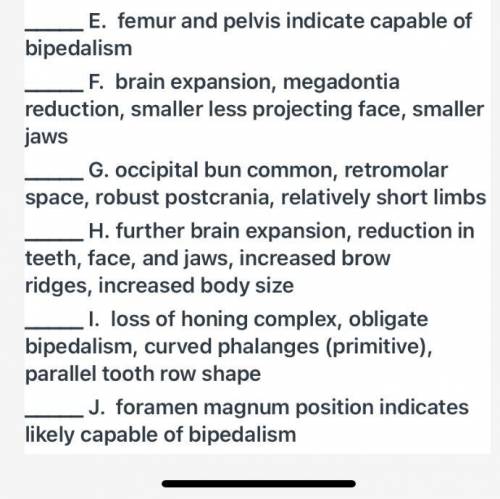
Biology, 26.07.2021 20:10 tarangorogelio
Step One: Anatomical Developments
Match the following anatomical developments (A-J) with the number where they occur on the Hominin Anatomy Phylogeny (below).
A. decreased prognathism, moderate sized molars, phalanges not curved (derived), Found in South Africa, still relatively small brain (-450cc)
B. canine reduction, lower jaw tooth row shape intermediate between parallel and parabolic, have footprints explicitly displaying bipedal
patterns, curved phalanges
C. further brain expansion, decrease in teeth size, decrease in brow ridges, flattening of the face, mental eminence, vertical forehead
D. megadontia complex (huge molars, jaws, and chewing muscles), slight increase in cranial capacity (410-530cc)
E. femur and pelvis indicate capable of bipedalism
F. brain expansion, megadontia reduction, smaller less projecting face, smaller jaws
G. occipital bun common, retromolar space, robust postcrania, relatively short limbs
H. further brain expansion, reduction in teeth, face, and jaws, increased brow ridges, increased body size
1. loss of honing complex, obligate bipedalism, curved phalanges (primitive), parallel tooth row shape
J. foramen magnum position indicates likely capable of bipedalism


Answers: 2


Another question on Biology

Biology, 21.06.2019 20:00
Animals such as pronghorn antelope, bison ans badgers dot to the landscape. where are these animals located?
Answers: 1

Biology, 22.06.2019 04:10
Select the correct answer. tay-sachs disease is caused by a mutation in the hexa gene located on chromosome 15. tay-sachs follows an autosomal recessive pattern of inheritance. with the of the diagram, identify which of the offspring will be an unaffected carrier. a diagram showing the genes of parents who are carriers of tay-sachs disease a. a, b, and c b. b and c c. a and d d. a e. d
Answers: 3

Biology, 22.06.2019 08:30
Both male and female gametes are created during the process of meiosis. the formation of male gametes is called spermatogenesis. after telophase il of spermatogenesis, there would be are all genetically male gametes created that
Answers: 2

You know the right answer?
Step One: Anatomical Developments
Match the following anatomical developments (A-J) with the number...
Questions



Mathematics, 03.08.2019 02:40




English, 03.08.2019 02:40

English, 03.08.2019 02:40


English, 03.08.2019 02:40

Arts, 03.08.2019 02:40


Mathematics, 03.08.2019 02:40


Mathematics, 03.08.2019 02:40

Business, 03.08.2019 02:40


Arts, 03.08.2019 02:40

Mathematics, 03.08.2019 02:40

Mathematics, 03.08.2019 02:40



